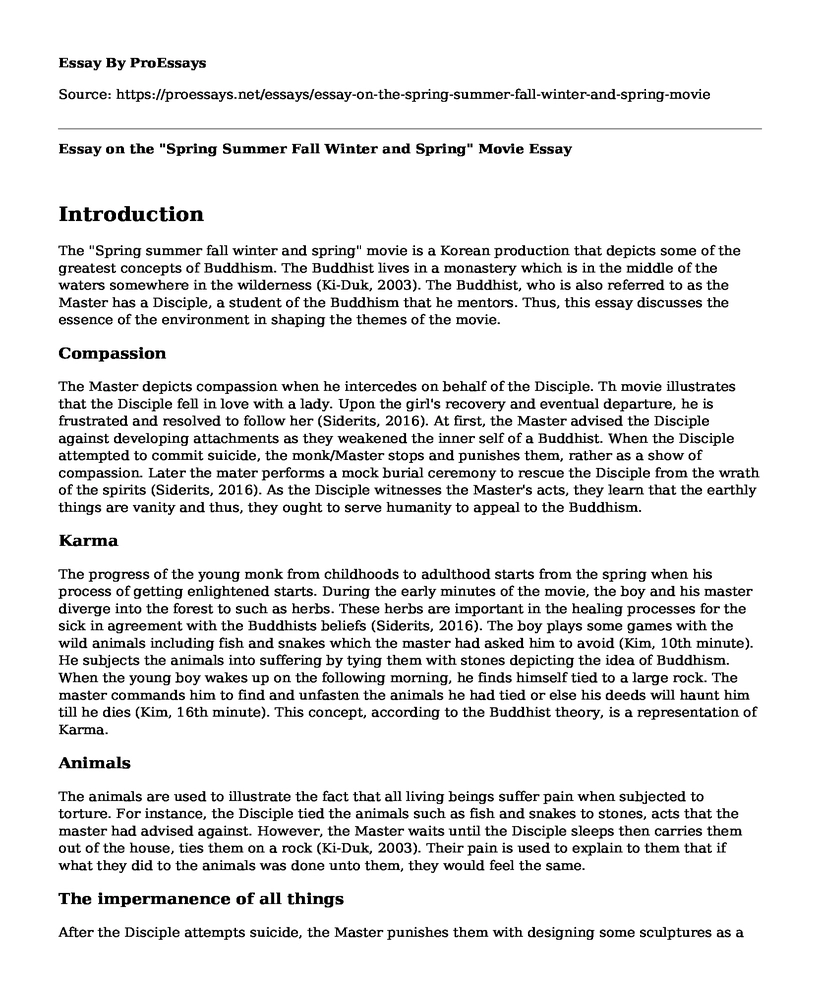Introduction
The "Spring summer fall winter and spring" movie is a Korean production that depicts some of the greatest concepts of Buddhism. The Buddhist lives in a monastery which is in the middle of the waters somewhere in the wilderness (Ki-Duk, 2003). The Buddhist, who is also referred to as the Master has a Disciple, a student of the Buddhism that he mentors. Thus, this essay discusses the essence of the environment in shaping the themes of the movie.
Compassion
The Master depicts compassion when he intercedes on behalf of the Disciple. Th movie illustrates that the Disciple fell in love with a lady. Upon the girl's recovery and eventual departure, he is frustrated and resolved to follow her (Siderits, 2016). At first, the Master advised the Disciple against developing attachments as they weakened the inner self of a Buddhist. When the Disciple attempted to commit suicide, the monk/Master stops and punishes them, rather as a show of compassion. Later the mater performs a mock burial ceremony to rescue the Disciple from the wrath of the spirits (Siderits, 2016). As the Disciple witnesses the Master's acts, they learn that the earthly things are vanity and thus, they ought to serve humanity to appeal to the Buddhism.
Karma
The progress of the young monk from childhoods to adulthood starts from the spring when his process of getting enlightened starts. During the early minutes of the movie, the boy and his master diverge into the forest to such as herbs. These herbs are important in the healing processes for the sick in agreement with the Buddhists beliefs (Siderits, 2016). The boy plays some games with the wild animals including fish and snakes which the master had asked him to avoid (Kim, 10th minute). He subjects the animals into suffering by tying them with stones depicting the idea of Buddhism. When the young boy wakes up on the following morning, he finds himself tied to a large rock. The master commands him to find and unfasten the animals he had tied or else his deeds will haunt him till he dies (Kim, 16th minute). This concept, according to the Buddhist theory, is a representation of Karma.
Animals
The animals are used to illustrate the fact that all living beings suffer pain when subjected to torture. For instance, the Disciple tied the animals such as fish and snakes to stones, acts that the master had advised against. However, the Master waits until the Disciple sleeps then carries them out of the house, ties them on a rock (Ki-Duk, 2003). Their pain is used to explain to them that if what they did to the animals was done unto them, they would feel the same.
The impermanence of all things
After the Disciple attempts suicide, the Master punishes them with designing some sculptures as a way of punishment during the fall part of the movie (65th minute). After the punishment, the monk falsifies a funeral for the boy in a move aimed at appeasing the spirits. This act aims at liberating the master and enhancing the maturity of the young boy (78th minute) (Ki-Duk, 2003). The whole scenario makes the boy understand that the worldly things will vanish (Siderits, 2016). Thus, the boy realizes that the feelings of attachment and the resolve to do wrong are all impermanent. According to the Buddhist religion, the aspect depicted in the scenario is known as impermanence.
Seeing through Buddhist Eyes
Through the acts of compassion, the punishments and the lessons such as being ties on a rock, the Disciple learns to view the universe through Buddhist eyes (Ki-Duk, 2003). The Buddhist perspective recognizes the impermanence of things, the concept of Karma and compassion, all taught by the Master, hence moulding the character.
Ki-du Kim, the director of the film, presents a unique Buddha vision concept, different from the typical God-trick movie productions (Ki-Duk, 2003). Thus, the movie accomplishes the objective by creating the Buddha-like subjectivity by focusing on either the characters in the film or the bodhisattvas, strengthening the essence of Buddha vision.
References
Ki-Duk, K. (2003). Spring, summer, fall, winter... and spring. Korea Films.
Siderits, M. (2016). Personal identity and Buddhist philosophy: Empty persons. Routledge.
Cite this page
Essay on the "Spring Summer Fall Winter and Spring" Movie. (2022, Apr 14). Retrieved from https://proessays.net/essays/essay-on-the-spring-summer-fall-winter-and-spring-movie
If you are the original author of this essay and no longer wish to have it published on the ProEssays website, please click below to request its removal:
- Paper Example on Minors and Social Networks
- John McCosh Photography Essay
- Documentary Films: Nonfictional Films to Preserve & Evolve - Essay Sample
- Movie Analysis Essay on Stagecoach
- Paper Example on Public Speaking: Improving My Social & Persuasive Skills
- Paper Example on Lil Uzi Vert's Eternal Atake: A Milestone in Hip-Hop History
- Paper Example on Theater as a Medium for Change: Amy Fritsche's Insight







